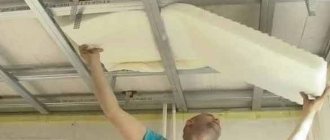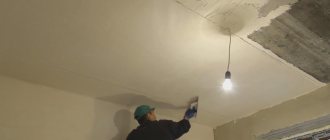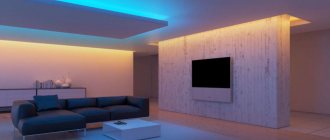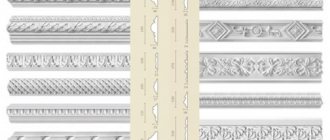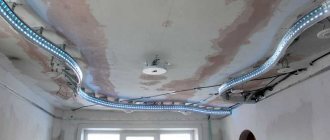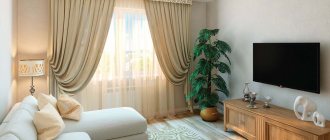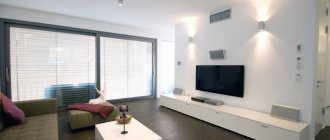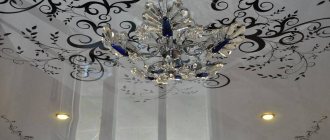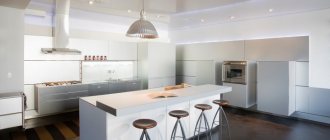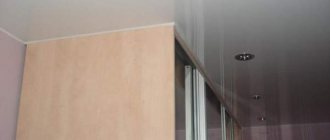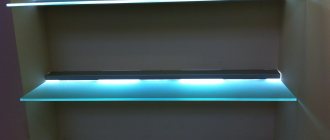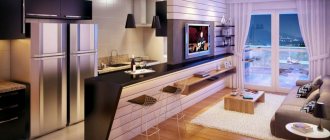From this article you will learn:
- What is the difference between frameless soundproofing of the ceiling in an apartment and sound absorption?
- What is frameless soundproofing of the ceiling in an apartment?
- What materials are used for frameless soundproofing of the ceiling in an apartment?
- How to install frameless soundproofing of the ceiling in an apartment with your own hands
Living in an apartment building in Moscow, many are faced with the need to soundproof walls, floors and ceilings. When choosing an apartment, many factors can be taken into account, but no one is safe from noisy neighbors. And if the family living above has a small child, soundproofing the ceiling is simply vital.
Properly performed sound insulation will help make your home quiet and comfortable; in addition, modern sound insulation of ceilings can not only fulfill its main purpose, but also decorate the interior of your apartment.
In this article we will look at one of the options for combating noise - frameless soundproofing of the ceiling in an apartment.
What is the difference between frameless soundproofing of the ceiling in an apartment and sound absorption?
Traditionally, people tend to confuse the concept of sound insulation and sound absorption. Meanwhile, these are completely different phenomena and processes, although they give a similar result.
The main difference between sound insulation is the absorption of external sounds, the source of which is located outside the room. Sound absorption is designed to reduce the power of sound waves arising in the internal volume of the room. Therefore, to achieve these, in principle, different goals, appropriate materials and technologies are used.
If the goal is to reduce sound from neighbors or from the street, then high-quality sound insulation is necessary. If it is necessary to reduce the noise occurring indoors, sound-absorbing materials are installed.
What is frameless soundproofing of the ceiling in an apartment?
Most often, frameless sound insulation is installed together with suspended ceilings, sometimes the widespread plasterboard serves as the finishing layer covering the sound insulation layers.
When using a stretch ceiling, a sound wave arriving from the outside travels the distance between the ceiling slab and the stretch ceiling, is reflected from the surface and returns to the surface of the slab again. This is repeated several times, creating a drum effect. Sound insulation in this case allows you to fill the space between the floor slab and the suspended ceiling. It absorbs incoming sound vibrations and prevents their reflection from surfaces. It is worth noting that this type of sound insulation is effective against airborne, quiet noise, but will not help against sharp, impactful sound.
A standard frameless sound insulation system in an apartment consists of the following elements:
- soundproofing material, which can be of membrane type, or also consist of special slabs and panels;
- adhesive material;
- disc-type dowel-nails;
- fabric that is stretched between the floor slab and the decorative stretch ceiling.
The thickness of the soundproofing material in this case can vary from 1.4 to 4 cm. And the additional noise absorption index with such a sound insulation design can reach a value of 7-9 dB.
According to professionals, the suspended ceiling itself dampens about 5 dB of sound. The technology, thanks to which suspended ceilings are attached not to the floor slab, but to the walls of the room, also contributes to sound insulation - noise is not transmitted directly from the slab to the stretched material. In addition, any suspended ceiling is installed with an air gap, which also insulates the room from noise coming from outside.
When using a suspended ceiling, there is also an air space between the floor slab and the plasterboard, but the fastening system is such that the profile transmits sound from the floor slab to the plasterboard layer. Therefore, the soundproofing properties of a stretch ceiling are still significantly higher than those of a suspended ceiling.
For many people, the soundproofing properties of a standard stretch ceiling will still not be enough, and here it is important not to make a mistake and choose the most suitable material that will act as a soundproofing layer between the floor slab and the stretch ceiling.
The soundproofing characteristics of the ceiling will directly depend on the thickness of the selected material. Although modern materials with a relatively small thickness have excellent soundproofing characteristics, therefore losses in the height of the rooms will be minimal.
The second version of a frameless soundproofing system for ceilings in an apartment is also used:
- special sandwich panels with special vibration-isolating fastening units for the ZIPS system;
- vibration-isolating gasket;
- sealing element;
- special fasteners;
- a layer of drywall specially attached to soundproofing panels.
The use of a design using ZIPS additionally soundproofs the room by 11-18 dB, while the insulation thickness varies between 5.5-13.3 cm.
We choose the level of frameless sound insulation of the ceiling in the apartment and understand the types of noise
Some factors that directly affect the effectiveness of the ceiling soundproofing system in an apartment:
- Type of soundproofing material. Each material has different soundproofing properties and characteristics.
- The thickness of the layer of soundproofing material. For standard materials, the rule works - the thicker the layer, the higher the sound insulation. Although modern materials with a relatively small thickness have high sound insulating properties.
- Number of layers and material of each layer. Practice shows that sound insulation consisting of several layers of different materials gives the best results.
- Type of final coating.
If soundproofing is carried out in an apartment with high ceilings, then you can choose any modern soundproofing material, or better yet, a combination of materials. In such structures, a combination of roll material with gypsum plasterboard and gypsum fiber boards is usually used. The ceiling will lose 7.5-12 centimeters in height.
If the room has relatively low ceilings, then multi-layer sound insulation made from modern materials under a suspended ceiling is suitable. The loss of height will be an average of 3 centimeters, and a maximum of 6 centimeters.
Two types of noise can enter a room from the outside: airborne and impact.
Airborne noise is created by neighbors talking, a crying child, pets, the operation of a vacuum cleaner, etc. Impact noise is generated by mechanical impact on the floor of the apartment above. This could be stomping, dropping an object on the floor, moving furniture.
A special conversation about panel houses. In them, sounds from neighbors are transmitted not only through the ceilings, but also through wall panels and supporting structures of the house. Therefore, in a panel house, the partitions separating the room from the neighbors are also soundproofed.
In brick houses, the sound insulation of wall material is much higher, so if the house is brick, only the ceiling of the apartment will need to be soundproofed.
Partitions in monolithic frame houses are thinner than ceilings, so in such houses sound insulation is required first of all for the walls, and only then for the ceiling.
MaxForte
The new generation of rolled material is made without phenol, has the highest noise protection, and withstands moisture. Thickness 12 mm, contains no glue, used for frame and frameless stretch ceilings.
Installation of Armstrong suspended ceiling and installation prices
Characteristics:
- size (cm) 500x140x1.2;
- roll area 7m2;
- roll weight 16 kg;
- color options – black/white.
There is a variety of EcoAcoustic brand products on sale - slabs of polyester fibers made from primary raw materials. Products without phenol and glass fiber have hypoallergenic properties, withstand moisture, and retain shape stability throughout their entire service life. Sound absorption class A is the highest.
Characteristics:
- size (cm) 120x60x5;
- slab area (4 pcs.) 2.88 m2;
- density 100 g/m2;
- package weight 3 kg.
Laying rolls and slabs with complete overlap of the base base end-to-end, fixing with dowels.
What materials are frameless soundproofing of the ceiling in an apartment made from?
Today, there are various sound-absorbing and sound-reflecting materials on the market; let’s take a closer look at the main ones:
Plates "Stopzvuk"
Membrane-type soundproofing material. This material has a small thickness, only 2.5-14 mm. Due to its structure, this material does not absorb, but reflects sound. But this material has one significant drawback - high cost.
Recommended articles on this topic:
- Arrangement of a small apartment
- Stages of renovation in an apartment
- Turnkey cosmetic repairs
Roll material Tecsound
It is a soundproofing panel consisting of several layers of different materials. Due to their massiveness and multi-layered nature, they perfectly reduce both ordinary noise and shock waves. In its structure, this material contains various particles, for example, “EcoZvukoIzol” from SoundGuard is made of seven-layer cardboard filled with quartz sand particles. The use of free particles allows increasing the sound absorption of the material.
Panels
One of the varieties of ZIPS panels. This sound insulation consists of gypsum fiber and mineral wool. SoundGuard panels are mounted using special fasteners and are equipped with vibration units. After installation, the panels are covered with plasterboard.
Sandwich panel ZIPS
The so-called "Penoplex". Initially, the material was developed as a heat-insulating material, but during testing it showed excellent sound-proofing qualities. The material is relatively inexpensive and easy to install. However, when choosing, you should take into account one of its properties - it perfectly damps impact noise, but copes worse with ordinary acoustic noise.
Styrofoam
The material, familiar to everyone, is cheap, but ineffective as a soundproofing material. In addition, when burning, polystyrene foam releases harmful substances, including very toxic styrene. Are the financial savings worth the risks?
Cork material
Environmentally friendly, natural material. It has good sound insulation characteristics, but it is worth remembering that for effective sound insulation one layer of cork material of 1 cm will not be enough.
Today there is a great variety of soundproofing materials on the market; it is impossible to list all their types within the scope of this article. It is worth saying that in addition to those mentioned above, coconut fibers, liquid glass, polyurethane foam and other modern materials are used as soundproofing materials.
Expanded polystyrene panels
Modified foam boards are up to 10 cm thick and are made from unpressed or extruded polystyrene foam.
Characteristics:
| Options | Unpressed polystyrene foam | Extruded polystyrene foam |
| Sound absorption coefficient | Up to 27 dB | Up to 53 dB |
| Flexural strength | Up to 1 mPa | Up to 0.2 mPa |
| Density kg/m2 | 28-45 | 15–35 |
| Temperature | From -50 C to +75 C | From -50 C to +70 C |
| Flammability | G1 (moderate) | G4 (flammable) |
Unpressed foam plastic is designated PSB-S and is produced from granules of different sizes, which determine the density, strength and sound insulation performance. For finishing ceilings, it is recommended to use materials with medium and low density, light weight, for example, PSB-S 25/35. Fixation with glue without aggressive solvents, so as not to deform the materials. Laying end-to-end, seal the seams with tape, additionally secure with dowels.
How to make a ceiling with your own hands in a private wooden house
Extruded polystyrene foam has a high density and is produced by extrusion - pressing raw materials through special molding nozzles. The slabs are equipped with a tongue-and-groove locking connection, which facilitates installation. They are also produced in the format of small lamellas; after laying out, a smooth monolithic surface is obtained.
Important! With a thickness of 2 cm, extruded polystyrene foam dampens and disperses shock and sound noise up to 27 dB. The indicator increases with increasing thickness.
The same materials are used for laying out the sheets as for standard polystyrene foam.
Advantages of both types of expanded polystyrene:
- light weight;
- resistance to mold, mildew;
- reduced coefficient of thermal conductivity, increased coefficient of sound absorption.
Flaws:
- The materials belong to the flammable class. When heated, substances harmful to the body are released.
- Does not tolerate UV rays.
- During its service life it will self-decompose, crumble and require replacement.
Advice! To mitigate the disadvantages, it is recommended to choose self-extinguishing types of material impregnated with fire retardant. A certificate and recommendations from the manufacturer will help you identify such a product.
Installation is simple, the slabs are glued to the ceiling, then fixed with dowels. For hardware, holes are pre-drilled in the elements. Drill with a drill, being careful not to crumble the foam.
Do-it-yourself frameless soundproofing of the ceiling in an apartment
When installing frameless soundproofing of the ceiling in an apartment, you must have a certain set of tools and consumables:
- “mushroom-plug” fastening;
- roulette;
- adhesive material;
- building level;
- soundproofing material.
The installation algorithm for frameless ceiling sound insulation in an apartment is as follows:
- Cleaning the ceiling surface, applying primer to it and waiting for it to dry.
- The glue is applied along the edges and center of the panel; there is no need to coat the entire area; work begins by gluing the panel in the corner of the room. The following panels are glued as closely as possible to each other.
- After securing all the panels, we begin installing the fungi, placing them in the center and in the corners - from 2 to 5 fungi for each individual panel.
- We install a classic stretch ceiling - fabric or the more common film.
- If it is impossible to use materials with a large thickness, in order not to lose the height of the ceiling, you can use modern composite materials as sound insulation. They are very expensive, but they provide up to 24 dB of sound absorption, while they are thin, which will allow you not to lose vital space in rooms with low ceilings. Such material will take only 1.2-2.4 cm in height.
Soundproofing stages
So, how to soundproof the ceiling in an apartment? This is only possible when it is decided to install a suspended acoustic ceiling.
Even if you don’t plan on redecorating any time soon, or if it has just recently been completed and you have concerns about its safety, don’t worry.
Such work can be carried out at any time. Remember! Since the thickness of the “new” ceiling will be about 12-17 cm, such work is carried out on high ceilings.
But their height should not exceed 3 meters. The main stages of sound insulation for an apartment ceiling:
- installation of fastenings for components . They are mounted through a vibration-insulated mounting unit using dowel screws or anchors;
- Horizontal profiles are mounted on hangers : they will ensure that the sound insulation is attached to the ceiling. Using a building level, check their levelness and level if necessary. The distance of the profiles from the walls on each side must be at least 5 mm;
- use of sound-absorbing material for installation between the suspended ceiling and the external ceiling . Most often, slabs based on mineral wool, fiberglass or non-combustible materials are used for these purposes;
- installation of plasterboard layer . The material is secured with self-tapping screws along or across the profiles. Drywall should also not reach the walls to prevent the formation of noise transmission channels in the room;
- between the surface of the walls and the created suspended ceiling, secure the Vibrostek-M gasket .
By making soundproofing of the ceiling in an apartment with your own hands using this method, you will not only protect your apartment from irritating sounds, but also create a convenient frame for masking ventilation, wiring and other necessary communications under the ceiling structure.
